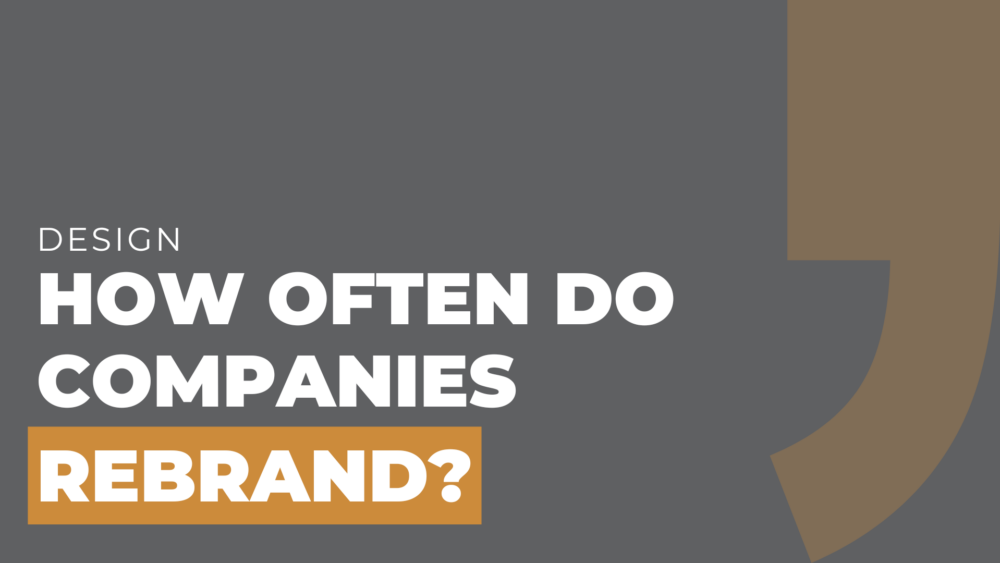In business, perception is everything.
And in a world moving at lightning speed—where trends evolve overnight and customer loyalty is earned in seconds—how often do companies rebrand to stay in the game?
Here’s the short answer: more often than you’d think.
A staggering 74% of the top S&P 100 companies have undergone rebranding within just seven years. That tells us one thing—refreshing their brand isn’t just a design decision. It’s a strategic move tied to survival, relevance, and growth.
But rebranding isn’t always smooth sailing.
Not every makeover story ends happily. We’ll get into that later.
So, how often should companies rebrand? And more importantly—should you?
Let’s dig in.
What Is Rebranding?
Rebranding is more than a new logo or a shiny website.
It’s a realignment of how a company presents itself to the world—visually, verbally, and strategically.
It may involve changing the name, logo, messaging, website, tone of voice, or all of the above.
The goal is always the same: create a clearer, stronger connection with your audience while reflecting your business’s growth, values, or direction.
Sometimes it’s sparked by internal shifts—new leadership, a merger, product changes.
Other times, it’s a response to a crisis, a redefined audience, or market pressure.
Whatever the reason, rebranding is about closing the gap between who you are and how you’re seen.
So… How Often Do Brands Rebrand?
There’s no magic number—but we’ve got some data points to go on:
- Average brand lifecycle: 7–10 years
- S&P 100 brands rebranded: 74% in 7 years
- Most rebrands driven by growth, market repositioning, or M&A
Most companies refresh their brand identity about once a decade.
Some rebrand every 5 years, especially in fast-moving industries like tech or retail.
Others stay the same for 20+ years and evolve slowly over time.
But here’s the truth: if your brand no longer reflects who you are—or worse, turns people away—it’s time.
According to a 2023 study, 60% of consumers avoid companies with unattractive or outdated logos, even if those brands have stellar reviews.
Design drives trust.
Design drives clicks.
Design drives decisions.
When Do Companies Choose to Rebrand?
It usually comes down to one (or more) of these five reasons:
1. Business Growth or Expansion
You’ve outgrown your current image.
What worked for a startup won’t support a scaling business.
According to Deloitte, 81% of high-growth companies have rebranded at least once to support rapid change.
2. Mergers, Acquisitions, or Structural Change
When two brands become one—or a company evolves—branding has to reflect that shift.
Example: SunTrust and BB&T didn’t just mash logos. They became Truist, with a unified identity that told a new story.
Around 80% of rebrands are triggered by mergers or acquisitions.
3. Poor Market Positioning
Sometimes the brand just isn’t landing.
It’s outdated, unclear, or misaligned with the market.
Rebranding allows a company to clarify its offering and reach the right audience.
According to Siegel+Gale, 91% of customers say simplicity improves purchase decisions—and rebranding can help get you there.
4. Customer Perception Has Shifted
You might still love your logo.
But if your audience has moved on, that loyalty fades.
Brands that ignore perception drift risk losing relevance.
Rebranding helps reconnect with today’s customer.
5. Technology, Trends, and Design Standards Have Evolved
What looked “fresh” in 2014 feels tired in 2024.
Rebranding keeps your design modern, messaging sharp, and digital experience competitive.
And remember—not every makeover story ends happily. Just ask Gap, who reversed their rebrand in under a week.
Is Rebranding Worth It?
Let’s be honest—it’s not cheap.
But cost isn’t just financial.
There’s time, creative energy, team buy-in, and the emotional labor of letting go of a legacy look.
Still, when done right, the ROI is real.
Here’s why companies say it’s worth it:
- Reputation Reset: Signals growth, evolution, and confidence
- Differentiation: Helps you stand out in crowded markets
- Audience Alignment: Your audience evolves—your brand should too
- Sales Impact: Boosts performance in ads, pitches, and proposals
- Internal Morale: Gives your team renewed pride and clarity
But remember—rebranding is a strategy, not a Band-Aid.
It requires deep research, creative consistency, and intentional rollout across every touchpoint—from website to business cards.
Common Rebranding Mistakes to Avoid
Learn from the companies that didn’t get it right:
- Changing everything at once, without a roadmap
- Ignoring the customer’s voice
- Following trends instead of leading with clarity
- Skipping internal alignment
- Launching without a transition plan
And the biggest mistake?
Rebranding when you don’t actually need to.
Sometimes all you need is a brand refresh—a visual polish, tone update, or improved messaging.
Not a total overhaul.
Know the difference.
Real Talk: Should You Rebrand?
Use this checklist to assess your brand’s health:
- Has your audience changed?
- Has your mission evolved?
- Are you expanding markets or services?
- Are you often confused with competitors?
- Does your brand feel outdated—visually or verbally?
- Are you proud of how you show up online?
If you checked yes to two or more—it’s time to consider your next move.
Remeber, this is a strategic decision that should have clear data backing up any moves.
At the End of the Day
How often do companies rebrand?
About once a decade.
But the real question is: how often should you evaluate your brand?
If your current identity doesn’t reflect your value, connect with customers, or fit where you’re headed—it’s time.
You don’t have to figure it out alone.
At MOCK, the agency, we guide rebrands from start to finish—with clarity, speed, and killer creative.
We don’t just give you a new look.
We give you something that works.
Let’s talk. We’ll meet you where you are—and help you get where you’re going.
Let’s Make It Happen
- Website: https://mocktheagency.com/
- Phone: 470-225-6814
- Email: hello@mocktheagency.com
- Address: 247 14th St NW, Atlanta, GA 30318


Comments are closed.